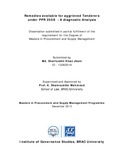| dc.contributor.advisor | Prof. K. Shamsuddin Mahmood | |
| dc.contributor.author | Jilani, Md. Sharfuddin Khan | |
| dc.date.accessioned | 2013-12-31T06:53:14Z | |
| dc.date.available | 2013-12-31T06:53:14Z | |
| dc.date.copyright | 2012 | |
| dc.date.issued | 2012-12 | |
| dc.identifier.other | ID 12282016 | |
| dc.identifier.uri | http://hdl.handle.net/10361/2794 | |
| dc.description | This dissertation report is submitted in partial fulfillment of the requirements for the degree of Masters in Procurement and Supply Management, 2012. | en_US |
| dc.description | Cataloged from PDF version of thesis report. | |
| dc.description | Includes bibliographical references (page 100 -102 ). | |
| dc.description.abstract | Like any other Public procurement rules/regulation/directives, Public
Procurement Rules 2008 (PPR 2008) has also well defined grievance
remedy procedures. Under the PPR 2008, there are four stages of
complaints lodge procedure. But seeking remedy at the level of the
Review Panel is the last stage of getting remedy by a tenderer. Actually,
the enforcement of rules of PPR 2008 relies heavily on
complaints/appeal petitions brought by aggrieved tenderer for public
contracts before the four stages of complaints lodge procedure
specifically at Review Panel level.
The study considers the extent to which the existing remedial system,
available for aggrieved tenderer under PPR 2008, is an effective
mechanism through text-based research, by analyzing the text of
related statutes and records of disposed appeal petitions, and validation
of the observations/data, found by reviewing the contents of disposed
appeal petitions, by conducting interviews with a tiny size of sample.
The findings of the research indicate that with all its weaknesses the
existing remedy procedure is best available mechanism for ensuring
transparency, efficiency and accountability in the public procurement
system of Bangladesh. But for making it effective in true sense
immediate intervention is needed from strategic level in the forms of (i)
ensuring intensive monitoring of the procurement processes by the
supervisory layer, (ii) ensuring proper functioning of three tiers of the
administrative remedy procedure, (iii) taking initiative from the
government side to formally orient the tenderer about the remedy
provision, and (iv) issuing circular explaining the areas, where
disagreements are being happening during interpretation, and providing
the correct interpretation by the CPTU. Before this study was undertaken, no study was conducted on remedy procedures available for the tenderer under the PPR 2008. It is hoped that the study would shed light on different related issues and will be of
some use to policy makers. | en_US |
| dc.description.statementofresponsibility | Md. Sharfuddin Khan Jilani | |
| dc.format.extent | 117 pages | |
| dc.language.iso | en | en_US |
| dc.publisher | BRAC University | en_US |
| dc.rights | BRAC University dissertation reports are protected by copyright. They may be viewed from this source for any purpose, but reproduction or distribution in any format is prohibited without written permission. | |
| dc.subject | Remedial system | en_US |
| dc.subject | Transparency | en_US |
| dc.subject | Accountability | en_US |
| dc.subject | Procurement and supply management | |
| dc.title | Remedies available for aggrieved tenderers under PPR 2008 : a diagnostic analysis | en_US |
| dc.type | Dissertation | en_US |
| dc.contributor.department | Institute of Governance Studies, BRAC University | |
| dc.description.degree | M. Procurement and Supply Management | |

